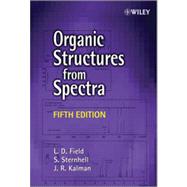
Note: Supplemental materials are not guaranteed with Rental or Used book purchases.
Purchase Benefits
What is included with this book?
LIST OF TABLES xi
LIST OF FIGURES xiii
1 INTRODUCTION 1
1.1 GENERAL PRINCIPLES OF ABSORPTION SPECTROSCOPY 1
1.2 CHROMOPHORES 3
1.3 DEGREE OF UNSATURATION 3
1.4 CONNECTIVITY 4
1.5 SENSITIVITY 5
1.6 PRACTICAL CONSIDERATIONS 5
2 ULTRAVIOLET (UV) SPECTROSCOPY 7
2.1 BASIC INSTRUMENTATION 7
2.2 THE NATURE OF ULTRAVIOLET SPECTROSCOPY 8
2.3 QUANTITATIVE ASPECTS OF ULTRAVIOLET SPECTROSCOPY 8
2.4 CLASSIFICATION OF UV ABSORPTION BANDS 9
2.5 SPECIAL TERMS IN ULTRAVIOLET SPECTROSCOPY 10
2.6 IMPORTANT UV CHROMOPHORES 10
2.7 THE EFFECT OF SOLVENTS 14
3 INFRARED (IR) SPECTROSCOPY 15
3.1 ABSORPTION RANGE AND THE NATURE OF IR ABSORPTION 15
3.2 EXPERIMENTAL ASPECTS OF INFRARED SPECTROSCOPY 16
3.3 GENERAL FEATURES OF INFRARED SPECTRA 16
3.4 IMPORTANT IR CHROMOPHORES 17
4 MASS SPECTROMETRY 21
4.1 IONISATION PROCESSES 21
4.2 INSTRUMENTATION 23
4.3 MASS SPECTRAL DATA 24
4.4 REPRESENTATION OF FRAGMENTATION PROCESSES 29
4.5 FACTORS GOVERNING FRAGMENTATION PROCESSES 30
4.6 EXAMPLES OF COMMON TYPES OF FRAGMENTATION 30
5 NUCLEAR MAGNETIC RESONANCE (NMR) SPECTROSCOPY 34
5.1 THE PHYSICS OF NUCLEAR SPINS AND NMR INSTRUMENTS 34
5.2 CONTINUOUS WAVE (CW) NMR SPECTROSCOPY 39
5.3 FOURIER-TRANSFORM (FT) NMR SPECTROSCOPY 40
5.4 THE NUCLEAR OVERHAUSER EFFECT (NOE) 41
5.5 CHEMICAL SHIFT IN 1H NMR SPECTROSCOPY 42
5.6 SPIN-SPIN COUPLING IN 1H NMR SPECTROSCOPY 53
5.7 ANALYSIS OF 1H NMR SPECTRA 56
5.8 CHANGING THE MAGNETIC FIELD IN NMR SPECTROSCPY 58
5.9 RULES FOR SPECTRAL ANALYSIS OF FIRST ORDER SPECTRA 59
5.10 CORRELATION OF 1H – 1H COUPLING CONSTANTS WITH 66
STRUCTURE
6 13C NMR SPECTROSCOPY 71
6.1 COUPLING AND DECOUPLING IN 13C NMR SPECTRA 71
6.2 DETERMINING 13C SIGNAL MULTIPLICITY USING DEPT 72
6.3 SHIELDING AND CHARACTERISTIC CHEMICAL SHIFTS IN 75
13C NMR SPECTRA
7 2-DIMENSIONAL NMR SPECTROSCOPY 81
/
7.1 COSY (CORRELATION SPECTROSCOPY) 83
7.2 THE HSQC (HETERONUCLEAR SINGLE QUANTUM 84
CORRELATION) OR HSC (HETERONUCLEAR SHIFT
CORRELATION) SPECTRUM
7.3 HMBC (HETERONUCLEAR MULTIPLE BOND CORRELATION) 86
7.4 NOESY (NUCLEAR OVERHAUSER EFFECT SPECTROSCOPY) 91
7.5 TOCSY (TOTAL CORRELATION SPECTROSCOPY) 92
8 MISCELLANEOUS TOPICS 94
8.1 SOLVENTS FOR NMR SPECTROSCOPY 94
8.2 SOLVENT INDUCED SHIFTS 95
8.3 DYNAMIC PROCESSES IN NMR - THE NMR TIME-SCALE 96
8.4 THE EFFECT OF CHIRALITY 98
8.5 THE NMR SPECTRA OF "OTHER NUCLEI" 99
9 DETERMINING THE STRUCTURE OF ORGANIC COMPOUNDS 100
FROM SPECTRA
9.1 SOLVING PROBLEMS 102
9.2 WORKED EXAMPLES 103
10 PROBLEMS 111
10.1 SPECTROSCOPIC IDENTIFICATION OF ORGANIC COMPOUNDS 111
10.2 THE ANALYSIS OF MIXTURES 397
10.3 PROBLEMS IN 2-DIMENSIONAL NMR 407
10.4 NMR SPECTRAL ANALYSIS 467
INDEX 493
The New copy of this book will include any supplemental materials advertised. Please check the title of the book to determine if it should include any access cards, study guides, lab manuals, CDs, etc.
The Used, Rental and eBook copies of this book are not guaranteed to include any supplemental materials. Typically, only the book itself is included. This is true even if the title states it includes any access cards, study guides, lab manuals, CDs, etc.